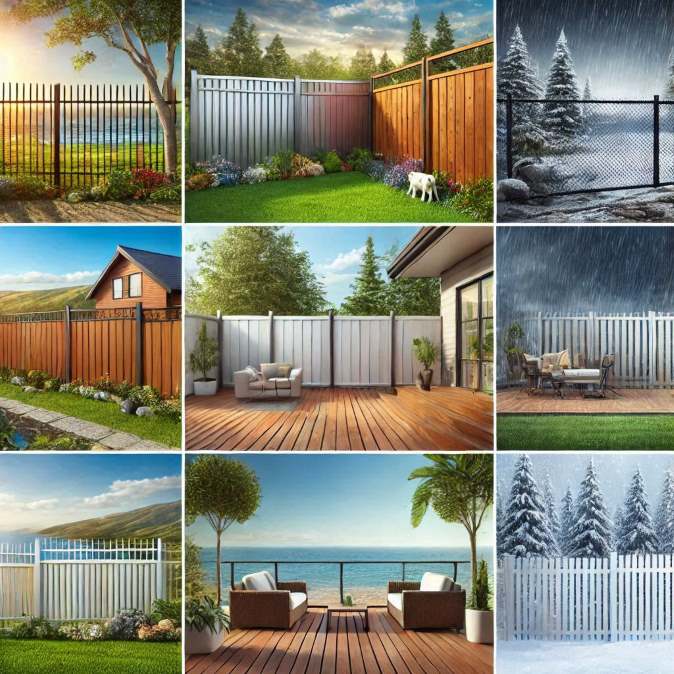Fencing is crucial in security, privacy, and defining property boundaries. What often goes unnoticed is the science behind its durability. The materials used and environmental factors largely determine how long a fence lasts and how well it performs under pressure. Everything from steel to wood reacts differently to changing climates and conditions.
Choosing the right fence is not just about aesthetics; durability matters. That’s why companies like Coxfence emphasize high-quality materials tailored to the specific needs of homeowners and businesses. Understanding these materials can help you make informed decisions.
The Role of Materials in Fence Longevity
 Each fencing material has its unique characteristics. These traits influence how long a fence can withstand the test of time and how it fares against environmental stressors.
Each fencing material has its unique characteristics. These traits influence how long a fence can withstand the test of time and how it fares against environmental stressors.
Steel Fencing: Strength and Versatility
Steel is one of the most durable materials for fencing. Known for its tensile strength, it can resist strong winds, impacts, and even attempted breaches. Steel fences, especially those treated with galvanization or powder coating, are highly resistant to rust and corrosion. However, proximity to salty environments, like coastal areas, may reduce their lifespan unless properly maintained.
The flexibility of steel makes it ideal for residential, commercial, and industrial purposes. Regular inspections and touch-ups allow a steel fence to last decades without significant deterioration.
Wood Fencing: Natural Appeal with Challenges
Wood remains a popular choice for its aesthetic appeal. It blends beautifully with natural landscapes and offers a warm, classic look. However, wood is highly sensitive to weather conditions. Moisture can lead to rot, while excessive sun exposure may cause warping or cracking.
The type of wood used significantly affects its longevity. Hardwoods like cedar and redwood are more resistant to decay and pests than softwoods like pine. Applying sealants and stains can prolong the lifespan of a wood fence, but regular maintenance is non-negotiable.
Vinyl Fencing: Low Maintenance Durability
Vinyl fencing has grown in popularity due to its low-maintenance qualities. Made from polyvinyl chloride (PVC), it is highly resistant to moisture, rot, and pests. Unlike wood, it doesn’t warp or crack under direct sunlight, making it an excellent choice for regions with harsh weather conditions.
However, vinyl fences can become brittle in extremely cold climates, making them susceptible to cracking. They are also less effective in areas requiring significant force or impact resistance.
Aluminum Fencing: Lightweight Yet Resilient
Aluminum fences are lightweight, corrosion-resistant, and versatile. Unlike steel, aluminum doesn’t rust, making it perfect for coastal areas. It may not match steel’s strength, but its durability against weathering makes it a popular option for decorative and functional fencing.
Composite Fencing: A Modern Solution
Composite fencing combines wood fibres and plastic to offer the best of both worlds. It mimics the natural appearance of wood but with enhanced resistance to rot, pests, and weather. While it’s pricier than traditional materials, its low maintenance and long lifespan often justify the cost.
Environmental Factors and Their Impact on Fences
Environmental conditions play a significant role in the longevity of fences. Below are the primary factors influencing how fencing materials hold up over time.
Climate
Harsh winters, scorching summers, and heavy rains all affect fencing differently. For example, wood may expand and contract with temperature changes, while metal might corrode in humid conditions without proper treatment.
Soil Conditions
The type of soil where a fence is installed also matters. Loose or sandy soil may require deeper posts or stronger foundations to maintain stability. Poor drainage can lead to water accumulation, which is particularly harmful to wood fences.
Maintenance
Neglecting routine maintenance shortens the lifespan of any fence, regardless of its material. Regular cleaning, painting, and repairs can help identify early signs of wear and prevent costly replacements.
Tips for Choosing the Right Fence
- Consider Your Climate: Choose materials suited to your local weather conditions. For example, aluminum is ideal for wet regions, while treated wood works well in drier climates.
- Think About Purpose: Determine whether your fence is primarily for security, privacy, or decoration. Steel is best for security, while vinyl or composite may be better for aesthetics.
- Prioritize Quality: Investing in high-quality materials and professional installation from experts like Coxfence ensures your fence performs well and lasts longer.
READ ALSO: What To Ask And Look For In A Roof Replacement Contractor
The Future of Durable Fencing
Advances in materials science continue to enhance fencing options. Innovations like weather-resistant coatings, eco-friendly composites, and smart fencing solutions are changing the landscape of durability. These advancements extend the life of fences and minimize environmental impact.
Durable fencing is about more than just materials; it’s about understanding how different factors influence longevity. By choosing the right material and maintaining it properly, you can ensure your fence remains strong and beautiful for years to come.